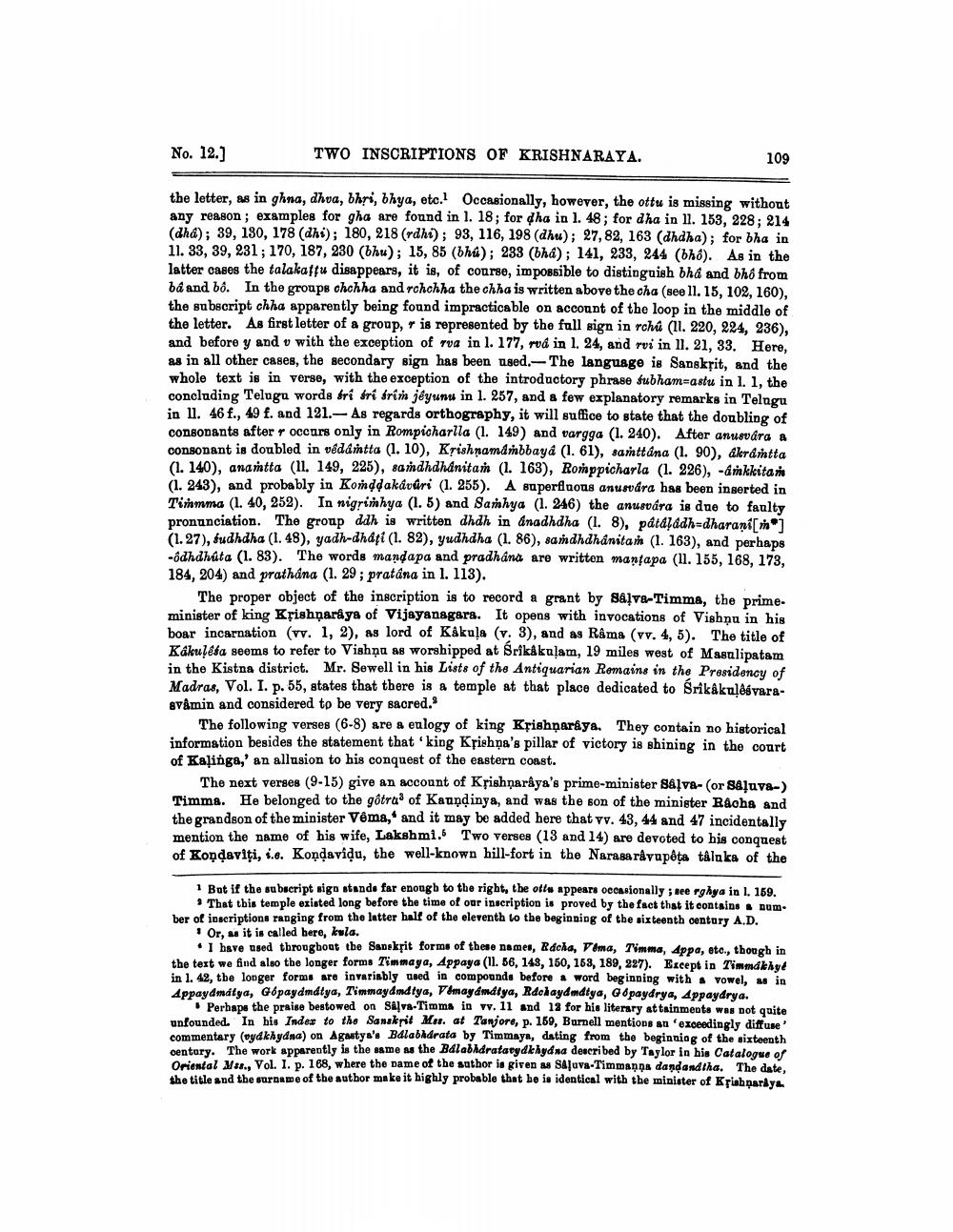________________
No. 12.]
TWO INSCRIPTIONS OF KRISHNARAYA.
109
the letter, as in ghna, dhua, bhri, bhya, etc. Occasionally, however, the ottu is missing without any reason ; examples for gha are found in 1. 18; for dha in l. 48; for dha in 11. 153, 228; 214 (dha); 39, 130, 178 (dhi); 180, 218 (rdhi); 93, 116, 198 (dhu); 27, 82, 163 (dhdha); for bha in 11. 33, 39, 231; 170, 187, 230 (hu); 15, 85 (ha); 233 (bhá); 141, 233, 244 (bhô). As in the latter cases the talakaffu disappears, it is, of course, impossible to distinguish bha and bhô from bd and bô. In the groups chchha and Tchchha the chha is written above the cha (see 11. 15, 102, 160), the subscript chha apparently being found impracticable on account of the loop in the middle of the letter. As first letter of a group, r is represented by the full sign in rchi (II. 220, 224, 236), and before y and u with the exception of rua in l. 177, rvá in l. 24, and rvi in I. 21, 33. Here, as in all other cases, the secondary sign has been used. The language is Sanskrit, and the whole text is in verse, with the exception of the introductory phrase fubham-astu in l. 1, the concluding Telugu words fri frí frím jęyunu in l. 257, and a few explanatory remarks in Telugu in 11. 46 f., 49 f. and 121.-As regards orthography, it will sufice to state that the doubling of Consonants after r occurs only in Rompicharlla (1. 149) and vargga (1. 240). After anusvára a consonant is doubled in vedäntta (1. 10), Krishnamdmbbaya (1. 61), samttana (1. 90), Glerártta (1. 140), anamtta (11. 149, 225), sandhdhanitan (1. 163), Romppicharla (1. 226), -ámkkitan (1. 243), and probably in Konddakavúri (1. 255). A superfluous anusvára has been inserted in Timmma (1. 40, 252). In nigrimhya (1. 5) and Samhya (1. 246) the anusvára is due to faulty pronunciation. The group ddh is written dhdh in anadhdha (1.8), påtaladh-dharani[mo] (1.27), budhdha (1. 48), yadh-dhati (1. 82), yudhdha (1. 86), sandhdhánitar (1. 163), and perhaps - odhdhita (1. 83). The words mandapa and pradhana are written mantapa (11. 155, 168, 173, 184,204) and prathana (1. 29; pratána in l. 113).
The proper object of the inscription is to record a grant by SAVA-Timma, the prime. minister of king Krishnaraya of Vijayanagara. It opens with invocations of Vishnu in his boar incarnation (vv. 1, 2), as lord of Kåkula (v. 3), and as Rama (vv. 4, 5). The title of Kakup&ba seems to refer to Vishnu as worshipped at Srikakulam, 19 miles west of Masulipatam in the Kistna district. Mr. Sewell in his Lists of the Antiquarian Romains in the Presidency of Madras, Vol. I. p. 55, states that there is a temple at that place dedicated to SrikakulêsvaraSVÅmin and considered to be very sacred.
The following verses (6-8) are a eulogy of king Krishnaraya. They contain no historical information besides the statement that 'king Kțishna's pillar of victory is shining in the court of Kalinga,' an allusion to his conquest of the eastern coast.
The next verges (9-15) give an account of Krishnaraya's prime-minister salva-(or SAļuva-) Timma. He belonged to the gôtrad of Kaundinya, and was the son of the minister Raoha and the grandson of the minister Vêma, and it may be added here that vv. 43, 44 and 47 incidentally mention the name of his wife, Lakshmi. Two verses (13 and 14) are devoted to his conquest of Kondaviti, s.o. Kondavidu, the well-known hill-fort in the Narasa råvapôta tâlnks of the
1 But if the subscript sige stands far enough to the right, the otto appears occasionally see rghya in l. 159.
That this temple existed long before the time of our inscription is proved by the fact that it contains Bumber of inscriptions ranging from the latter half of the eleventh to the beginning of the sixteenth century A.D.
1 Or, as it is called bere, kula.
• I have used throughout the Sanskrit forms of these names, Rdcha, Toma, Timma, 4ppa, etc., though in the text we find also the longer forms Timmaga, Appaya (11. 56, 149, 150, 168, 189, 227). Except in Timmdkhye in l. 42, the longer forms are invariably used in compounds before & word beginning with a vowel, m in Appaydmdlya, Gópaydmdtya, T'immaydmdtya, Vemaydimdiya, Rdehaydudlya, Opaydrya, 4ppaydrya.
Perhaps the praire bestowed on SAVA-Timma in vv. 11 and 13 for his literary at tainments was not anita unfounded. In his Index to the Sanskrit Mar. at Tanjore, p. 169, Burnell mentions an exceedingly diffuse' commentary (oydkhydna) on Agastya's Bllabhdrata by Timmaya, dating from the beginning of the sixteenth century. The work apparently is the same as the Bdlabhdrataty dlhyd na described by Taylor in his Catalogue of Oriental Mus., Vol. I. p. 168, where the name of the suthor is given as Sauva-Timmanna dandand tha. The date, the title and the surname of the author make it highly probable that bo is identical with the minister of Kriahaar ve




